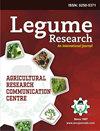Integrated use of Consortia-based Microbial Inoculants and Nutrient Complex Stimulates the Rhizosphere Microbiome and Soybean Productivity
IF 0.8
4区 生物学
Q3 AGRONOMY
引用次数: 0
Abstract
Background: The effectiveness of soybean inoculants in field conditions may be improved through the joint application of rhizobia and plant growth-promoting bacteria (PGPB). Plant nutrients may also contribute to the higher efficacy of microbial inoculants as well as the growth and development of plants. Methods: A field experiment was performed to evaluate the responses of the rhizomicrobiome and soybean to seed treatments with multiple bacterial strains (Bradyrhizobium japonicum, Bacillus subtilis, Bacillus megaterium and Azotobacter chroococcum), applied individually or in consortia, with and without nutrient complex (S, Mg, Mn, Fe, Zn, Cu, B and Mo). Result: Seed treatments with microbial consortia of Br. japonicum, B. subtilis/B. megaterium, A. chroococcum strains and nutrients had the highest effect on the abundance of total bacteria, nitrogen-fixing bacteria, actinomycetes and activity of dehidrogenase in the soybean rhizosphere. The highest effect on plant height, plant weight, pod number, pod weight, seed number and seed weight was obtained from treatment with Br. japonicum strains with nutrients, followed by co-inoculation with B. megaterium and A. chroococcum. In comparison with the control and Bradyrhizobium single inoculation, a statistically significant increase in the seed yield was recorded in treatment with Br. japonicum, B. megaterium, A. chroococcum and nutrients, reflecting the highest increase in protein and oil yield. The interactive effects of microbial consortia and nutrients could be used as promising seed technology for sustainable soybean cropping.综合利用菌丝体微生物接种剂和营养复合物刺激根际微生物群和大豆生产力
背景:通过根瘤菌和植物生长促进菌的联合施用,可以提高大豆接种剂在田间条件下的效果。植物营养素也可能有助于微生物接种剂的更高功效以及植物的生长和发育。方法:采用田间试验方法,研究不同菌种(日本慢生根瘤菌、枯草芽孢杆菌、巨芽孢杆菌和固氮杆菌)单独或联合施用,外加和不加营养物(S、Mg、Mn、Fe、Zn、Cu、B和Mo)对大豆根际微生物组和大豆的影响。结果:用Br菌群处理种子。枯草芽孢杆菌;对大豆根际总细菌、固氮细菌、放线菌丰度和脱氢酶活性影响最大的是巨芽孢杆菌、绿芽孢杆菌和营养物质。对株高、株重、荚果数、荚果重、种子数和种子重影响最大的是溴处理。然后与巨芽孢杆菌和绿芽孢杆菌共接种。与对照和单次接种缓生根瘤菌相比,Br处理的种子产量有统计学意义的显著提高。其中,蛋白质和油脂产量的增加幅度最大。微生物群落与养分的互作效应可作为大豆可持续种植的一种有前景的种子技术。
本文章由计算机程序翻译,如有差异,请以英文原文为准。
求助全文
约1分钟内获得全文
求助全文
来源期刊

Legume Research
AGRONOMY-
CiteScore
1.30
自引率
37.50%
发文量
256
审稿时长
6-12 weeks
期刊介绍:
Legume Research An International Journal. The Journal is an official publication of Agricultural Research Communication Centre. It is designed to bring out the original research articles on genetics, breeding, physiology, bacterial avtivity, production, quality, biochemistry and seeds of legumes crops. The objective of the journal is to serve as a forum for scientific community to publish their research findings on legumes ans to provide basis for new research. Journal is being scanned in the important indexing and abstracting services.
 求助内容:
求助内容: 应助结果提醒方式:
应助结果提醒方式:


